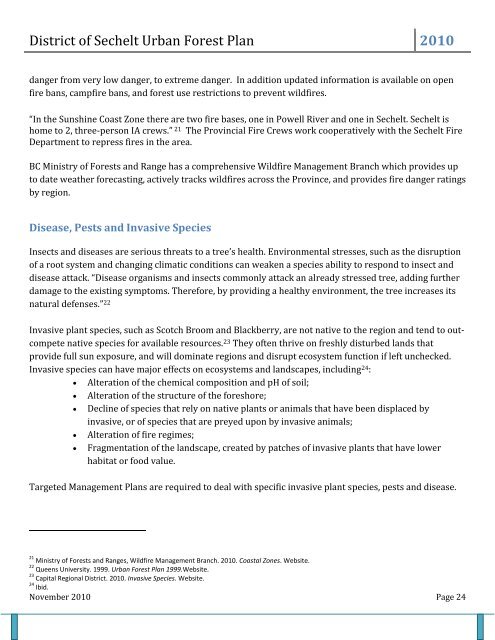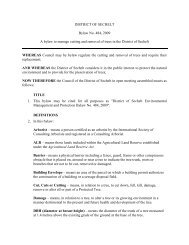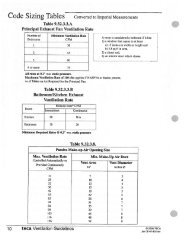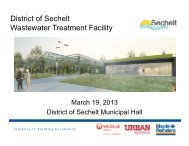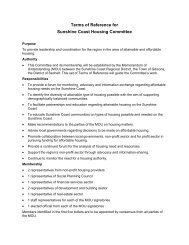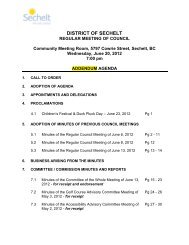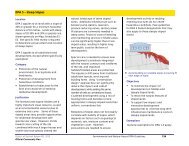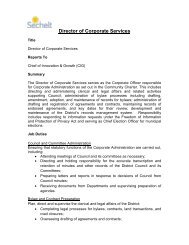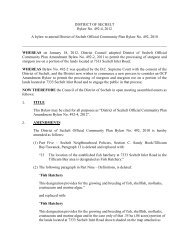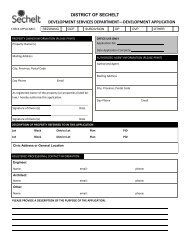District of Sechelt Urban Forest Plan
District of Sechelt Urban Forest Plan
District of Sechelt Urban Forest Plan
Create successful ePaper yourself
Turn your PDF publications into a flip-book with our unique Google optimized e-Paper software.
<strong>District</strong> <strong>of</strong> <strong>Sechelt</strong> <strong>Urban</strong> <strong>Forest</strong> <strong>Plan</strong> 2010<br />
danger from very low danger, to extreme danger. In addition updated information is available on open<br />
fire bans, campfire bans, and forest use restrictions to prevent wildfires.<br />
“In the Sunshine Coast Zone there are two fire bases, one in Powell River and one in <strong>Sechelt</strong>. <strong>Sechelt</strong> is<br />
home to 2, three-person IA crews.” 21 The Provincial Fire Crews work cooperatively with the <strong>Sechelt</strong> Fire<br />
Department to repress fires in the area.<br />
BC Ministry <strong>of</strong> <strong>Forest</strong>s and Range has a comprehensive Wildfire Management Branch which provides up<br />
to date weather forecasting, actively tracks wildfires across the Province, and provides fire danger ratings<br />
by region.<br />
Disease, Pests and Invasive Species<br />
Insects and diseases are serious threats to a tree’s health. Environmental stresses, such as the disruption<br />
<strong>of</strong> a root system and changing climatic conditions can weaken a species ability to respond to insect and<br />
disease attack. “Disease organisms and insects commonly attack an already stressed tree, adding further<br />
damage to the existing symptoms. Therefore, by providing a healthy environment, the tree increases its<br />
natural defenses.” 22<br />
Invasive plant species, such as Scotch Broom and Blackberry, are not native to the region and tend to outcompete<br />
native species for available resources. 23 They <strong>of</strong>ten thrive on freshly disturbed lands that<br />
provide full sun exposure, and will dominate regions and disrupt ecosystem function if left unchecked.<br />
Invasive species can have major effects on ecosystems and landscapes, including 24 :<br />
Alteration <strong>of</strong> the chemical composition and pH <strong>of</strong> soil;<br />
Alteration <strong>of</strong> the structure <strong>of</strong> the foreshore;<br />
Decline <strong>of</strong> species that rely on native plants or animals that have been displaced by<br />
invasive, or <strong>of</strong> species that are preyed upon by invasive animals;<br />
Alteration <strong>of</strong> fire regimes;<br />
Fragmentation <strong>of</strong> the landscape, created by patches <strong>of</strong> invasive plants that have lower<br />
habitat or food value.<br />
Targeted Management <strong>Plan</strong>s are required to deal with specific invasive plant species, pests and disease.<br />
21 Ministry <strong>of</strong> <strong>Forest</strong>s and Ranges, Wildfire Management Branch. 2010. Coastal Zones. Website.<br />
22 Queens University. 1999. <strong>Urban</strong> <strong>Forest</strong> <strong>Plan</strong> 1999.Website.<br />
23 Capital Regional <strong>District</strong>. 2010. Invasive Species. Website.<br />
24 Ibid.<br />
November 2010 Page 24


